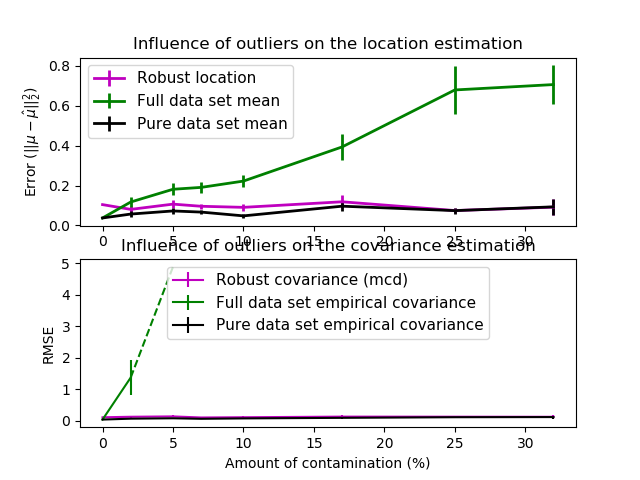sklearn.covariance.MinCovDet¶
class sklearn.covariance.MinCovDet(*, store_precision=True, assume_centered=False, support_fraction=None, random_state=None)
最小协方差决定(MCD):协方差的稳健估计器。
最小协方差决定估计器适用于高斯分布数据,也可适用于单峰、对称分布数据。它并不意味着用于多模态数据(用于拟合MinCovDet对象的算法在这种情况下很可能失败)。我们应该考虑投影追踪方法来处理多模态数据集。
在用户指南中阅读更多内容。
| 参数 | 说明 |
|---|---|
| store_precision | bool, default=True 指定是否存储估计的精度。 |
| assume_centered | bool, default=False 如果为True,则计算稳健位置和协方差估计的支持度,并重新计算协方差估计,而不会先将数据中心化。这在处理均值显着等于零但不完全为零的数据时很有用。如果为False,则直接使用FastMCD算法计算稳健位置和协方差,而无需进行其他处理。 |
| support_fraction | float, default=None 支持MCD原始估算的点数比例。如果为None,则将在算法中使用support_fraction的最小值: [n_sample + n_features + 1] / 2,范围是(0,1)。 |
| random_state | int or RandomState instance, default=None 确定用于数据混洗的伪随机数生成器。在多个函数调用之间传递同一个整数值以获得重复的结果。请参阅: Glossary <random_state>。 |
| 属性 | 说明 |
|---|---|
| raw_location_ | ndarray of shape (n_features,) 修正和重新加权前的稳健估计位置。 |
| raw_covariance_ | ndarray of shape (n_features, n_features) 修正和重新加权之前的原始稳健估计协方差。 |
| raw_support_ | ndarray of shape (n_samples,) 在修正和重新加权之前,用于计算位置和形状的原始稳健估计的观测数据掩模。 |
| location_ | ndarray of shape (n_features,) 估计的稳健位置。 |
| covariance_ | ndarray of shape (n_features, n_features) 估计的稳健协方差矩阵。 |
| precision_ | ndarray of shape (n_features, n_features) 估计的伪逆矩阵。(仅在store_precision为True时存储) |
| support_ | ndarray of shape (n_samples,) 用于计算位置和形状的稳健估计的观测掩模。 |
| dist_ | ndarray of shape (n_samples,) 训练集( fit称为)观测值的马氏距离。 |
参考
R9f63e655f7bd-Rouseeuw1984 P. J. Rousseeuw. Least median of squares regression. J. Am Stat Ass, 79:871, 1984.
R9f63e655f7bd-Rousseeuw A Fast Algorithm for the Minimum Covariance Determinant Estimator, 1999, American Statistical Association and the American Society for Quality, TECHNOMETRICS
R9f63e655f7bd-ButlerDavies R. W. Butler, P. L. Davies and M. Jhun, Asymptotics For The Minimum Covariance Determinant Estimator, The Annals of Statistics, 1993, Vol. 21, No. 3, 1385-1400
示例
>>> import numpy as np
>>> from sklearn.covariance import MinCovDet
>>> from sklearn.datasets import make_gaussian_quantiles
>>> real_cov = np.array([[.8, .3],
... [.3, .4]])
>>> rng = np.random.RandomState(0)
>>> X = rng.multivariate_normal(mean=[0, 0],
... cov=real_cov,
... size=500)
>>> cov = MinCovDet(random_state=0).fit(X)
>>> cov.covariance_
array([[0.7411..., 0.2535...],
[0.2535..., 0.3053...]])
>>> cov.location_
array([0.0813... , 0.0427...])
方法
| 方法 | 说明 |
|---|---|
correct_covariance(self, data) |
对原始的最小协方差行列式估计值进行修正。 |
error_norm(self, comp_cov[, norm, scaling, …]) |
计算两个协方差估计量之间的均方误差。 |
fit(self, X[, y]) |
用FastMCD算法拟合最小协方差决定。 |
get_params(self[, deep]) |
获取此估估算器的参数。 |
get_precision(self) |
获取精度矩阵 |
mahalanobis(self, X) |
计算给定观测值的平方马氏距离 |
reweight_covariance(self, data) |
重新加权原始最小协方差决定估计。 |
score(self, X_test[, y]) |
使用self.covariance_计算高斯数据集的对数似然值,作为其协方差矩阵的估计量。 |
set_params(self, **params) |
设置此估算器的参数。 |
__init__(self, *, store_precision=True, assume_centered=False, support_fraction=None, random_state=None)
初始化self. 请参阅help(type(self))以获得准确的说明。
correct_covariance(self, data)
对原始的最小协方差决定估计值进行修正。
使用Rousseeuw和Van Driessen在[RVD]中建议的经验校正因子进行修正。
| 参数 | 说明 |
|---|---|
| data | array-like of shape (n_samples, n_features) 用于计算原始估计值的数据集,具有p个特征和n个样本的数据矩阵。 |
| 返回值 | 说明 |
|---|---|
| covariance_corrected | ndarray of shape (n_features, n_features) 校正的稳健协方差估计。 |
参考资料
[RVD] Fast Algorithm for the Minimum Covariance Determinant Estimator, 1999, American Statistical Association and the American Society for Quality, TECHNOMETRICS
error_norm(self, comp_cov, norm='frobenius', scaling=True, squared=True)
计算两个协方差估计量之间的均方误差。(在Frobenius规范的意义上)。
| 参数 | 说明 |
|---|---|
| comp_cov | array-like of shape (n_features, n_features) 要比较的协方差。 |
| norm | {“frobenius”, “spectral”}, default=”frobenius” 用于计算误差的规范类型,可用的误差类型: - ‘frobenius’ (default): - ‘spectral’: 这里的A是 (comp_cov - self.covariance_)的误差 |
| scaling | bool, default=True 如果为True(默认),则平方误差范数除以n_features。如果为False,则不会重新调整平方误差范数。 |
| squared | bool, default=True 是计算平方误差范数还是误差范数。如果为True(默认),则返回平方误差范数。如果为False,则返回误差范数。 |
| 返回值 | 说明 |
|---|---|
| result | floatself和comp_cov协方差估计量之间的均方误差(按照Frobenius范式的含义) 。 |
fit(self,X,y = None )
用FastMCD算法拟合最小协方差决定。
| 参数 | 说明 |
|---|---|
| X | array-like of shape (n_samples, n_features) 训练数据,其中 n_samples是样本数量,n_features是特征数量。 |
| y | Ignored 未使用,出于API一致性目的而存在。 |
| 返回值 | 说明 |
|---|---|
| self | object |
get_params(self, deep=True)
获取此估计量的参数。
| 参数 | 说明 |
|---|---|
| deep | bool, default=True 如果为True,则将返回此估算器与其所包含子对象的参数。 |
| 返回值 | 说明 |
|---|---|
| params | mapping of string to any 参数名称映射到其值。 |
get_precision(self)
获取精确度矩阵。
| 返回值 | 说明 |
|---|---|
| precision_ | array-like of shape (n_features, n_features) 与当前协方差对象关联的精度矩阵。 |
mahalanobis(self, X)
计算给定观测值的平方马氏距离。
| 参数 | 说明 |
|---|---|
| X | array-like of shape (n_samples, n_features) 观测值,用来计算马氏距离。假定观测值与fit中使用的数据来自相同的分布。 |
| 返回值 | 说明 |
|---|---|
| dist | ndarray of shape (n_samples,) 观测值的平方马氏距离。 |
reweight_covariance(self, data)
重新加权原始最小协方差决定的估计值。
使用Rousseeuw在 [RVDriessen]中描述的方法(相当于在计算位置和协方差估计之前从数据集中删除离群点)重新计算观测值的权重。
| 参数 | 说明 |
|---|---|
| data | array-like of shape (n_samples, n_features) 用于计算原始估计值的数据集,具有p个特征和n个样本的数据矩阵。 |
| 返回值 | 说明 |
|---|---|
| location_reweighted | ndarray of shape (n_features,) 重新加权的稳健位置估计。 |
| covariance_reweighted | ndarray of shape (n_features, n_features) 重新加权的稳健协方差估计。 |
| support_reweighted | ndarray of shape (n_samples,), dtype=bool 用于计算重新加权的稳健定位和协方差估计的观测掩模。 |
参考资料
[RVDriessen] A Fast Algorithm for the Minimum Covariance Determinant Estimator, 1999, American Statistical Association and the American Society for Quality, TECHNOMETRICS
score(self, X_test, y=None)
使用self.covariance_作为协方差矩阵的估计值来计算高斯数据集的对数似然 。
| 参数 | 说明 |
|---|---|
| X_test | array-like of shape (n_samples, n_features) 计算似然性的测试数据集,其中n_samples是样本数,n_features是特征数。假定X_test与拟合(包括中心化)使用的数据来自相同的分布。 |
| y | Ignored 未使用,出于API一致性目的而存在。 |
| 返回值 | 说明 |
|---|---|
| res | float 数据集以 self.covariance_作为其协方差矩阵的估计量的似然性。 |
set_params(self, **params)
设置此估计器的参数。
该方法适用于简单的估计器以及嵌套对象(例如管道)。后者具有形式参数<component>__<parameter>以便可以更新嵌套对象的每个组件。
| 参数 | 说明 |
|---|---|
| **params | dict 估算器参数。 |
| 返回值 | 参数 |
|---|---|
| self | object 估算器对象。 |






